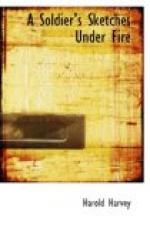THE HOLE IN THE WALL.
[Illustration: The hole in the wall.]
As a pictorial sequel to “Suicide Bridge” and my little account of the great fight there, hand to hand in the darkness, the next illustration will not be out of place. The barricade across the road, at the entrance to a village, marks the spot to which we advanced from the stream after that struggle in it. The clean hole in a remaining wall of the almost demolished house on the left had been cut by a shell. The house in ruins on the right had been a mansion, and pictures and furniture were strewn about—some of which we used in the trenches. A case of wine had been left behind unbroached. A cat left behind, that refused to quit, bore a charmed life—never was hit—and often ran about on the parapet. The parapet barricade of sandbags was called “The High Jump,” because we had to mount it and get over it each night and jump for our lives, to take up our positions by our advanced listening and observation post. It was absolutely fatal for anyone to show himself on the road in the daytime. Many a time we should have liked to have stretched our legs, but dared not. But after the fourth day we did actually get on the road, as the enemy shifted their position, and the relief was wonderful. It had been a speculation whether we or the Germans would get on the road, and after dislodging them we managed it. Our men ran about, some skipping with a piece of wire, others rolling on the ground, in their enjoyment of newly-found freedom, occasional spent bullets reaching us from a great distance. The position was always referred to as “Hole in the Wall.”
CHAPTER IX.
German beasts in A French Convent.
It is fitting that my sketch of a French Convent, as the abode of holy women whose innocent lives were dedicated and devoted to the service of the Prince of Peace, should stand by itself, apart from any drawings suggesting less faintly the devilry of war. The nunnery had been in the possession of the Germans for some short time before we arrived on the scene, and bore traces of their customary depredations and violations. The stories related by the nuns themselves were not of a description to bear retailing in the public Press. I would to God that they could be told to every coward of a shirker at home, to every skunk of a “conscientious objector,” to every rat of a “stop-the-war” “pacificist.” They would stir to boiling indignation the dregs of their manhood—if they have any dregs. They would make them sick—even them; and I should like them all to be sick—sick unto death. There are not many of them, all told, but they are noisy as well as noisome. The good sisters hailed the British as deliverers, and gave us a welcome I can neither describe nor forget.




